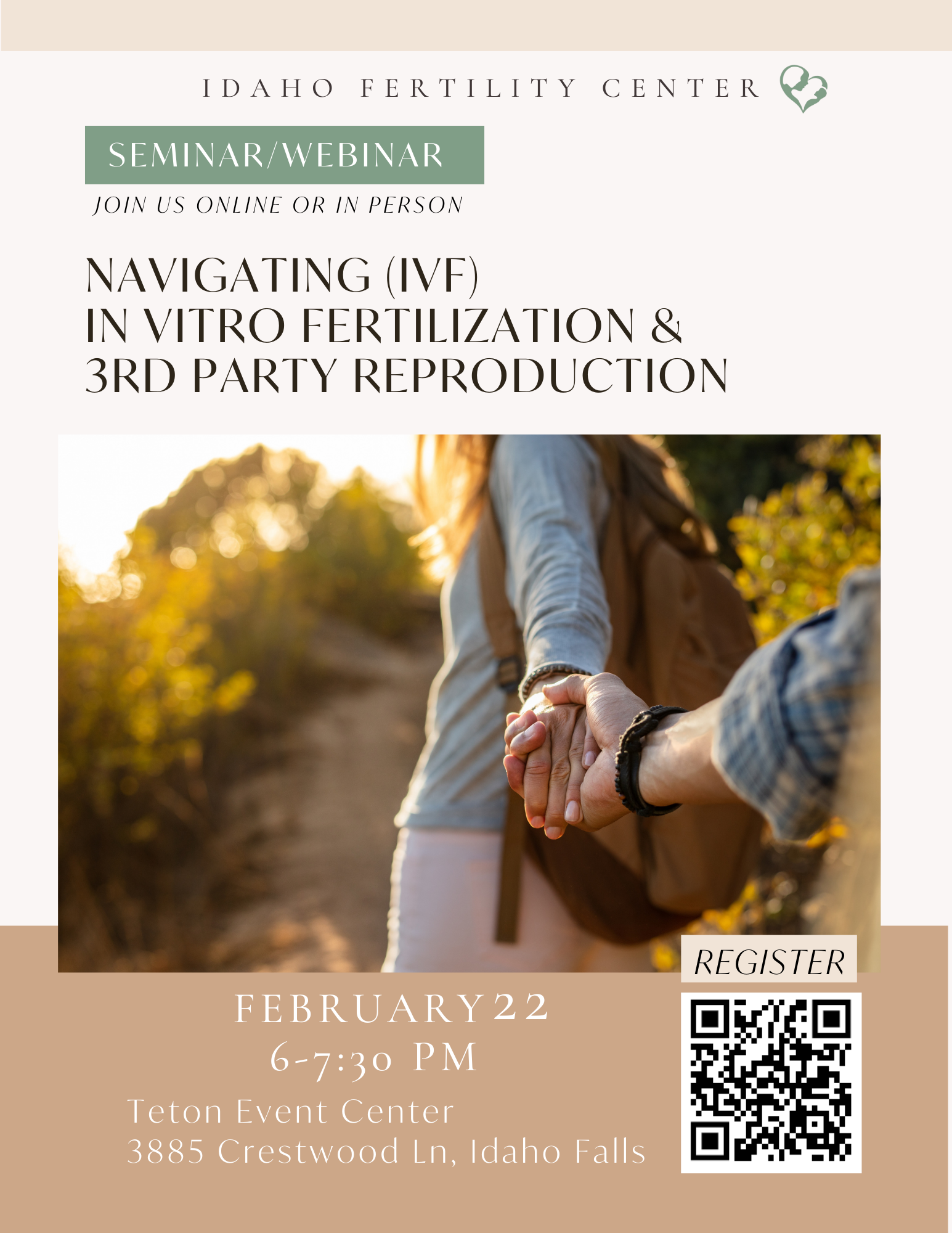What is In Vitro Fertilization?
In vitro fertilization (IVF) is the process where the female patient is given medication to stimulate several eggs to grow within the ovary. The eggs are then extracted through the vagina using a sonogram-guided needle under sedation. Sperm is then combined with the eggs to allow fertilization to take place. A few days later, the fertilized eggs are placed back in the uterus. IVF is effective for various types of infertility, including tubal disease, ovulation disorders, endometriosis, male factor, and unexplained infertility.
How much does it cost?
The cost will vary, as each patient/couple is given a customized treatment plan. We verify insurance coverage prior to your initial visit. The associated costs can be determined after meeting with your physician and establishing a plan. We offer discount programs and third-party financing. Please speak to our financial counselor for additional information.
The IVF Cycle
Evaluation
The need for IVF and cycle preparation is determined through a full evaluation, which includes in-depth patient education and a few diagnostic tests at our fertility clinic in Idaho Falls, Idaho, or one of our Utah clinics. This preparation may take 1-2 months.
Ovulation stimulation
Two hormonal medications are given at the onset of a woman’s menstrual cycle. One controls when a woman will ovulate and the other stimulates production eggs. These daily hormonal injections take place over 10 to 12 days. Two or three transvaginal ultrasounds are performed to observe the growth and maturity of the egg-containing follicles. Once mature (ready to ovulate), a third hormone is given to stimulate the eggs’ release (ovulation). This is usually cycle day 10 – 12.
Oocyte retrieval
One hour prior to the eggs releasing from the ovary, they are drawn out through a needle into a test tube. Anesthesia provides no pain, while the transvaginal ultrasound guides the needle into the separate follicles to aspirate the eggs. An average egg yield is approximately 15, but this varies widely.
Laboratory
The eggs are mixed or injected (ICSI) with the husband’s sperm. The lab is equipped with state-of-the-art instruments, microscopes, incubators, airflow hoods, and room filters to ensure the best possible outcomes. Usually, 60-70% of eggs retrieved will become fertilized (the same as in nature). These fertilized eggs are incubated over the next 5 days in the laboratory. Of genetic testing is included in the plan of care, biopsies are done on day 5 and sent f0r evaluation. Embryos are then frozen for subsequent frozen embryo transfers. Otherwise the embryo (s) are prepared for transfer to the uterus.
Embryo transfer
Five days after the egg retrieval and following evaluation of the quality of the developing embryos, a decision is made by the patients and the physician as to how many embryos will be transferred to the uterus. Your doctor will go over the number of embryos to transfer that will provide the highest probability of the success of a healthy pregnancy, while still trying to minimize the probability of a high order multiple pregnancy. You will receive information on your embryos and a picture of your embryos. Patients usually decide to transfer 1 to 2 embryos. In an atraumatic catheter and under ultrasound guidance, embryos are transferred through the cervix into the uterus. The procedure is pain-free. It is usually a very reassuring experience to see the embryos placed into the womb. High-quality embryos remaining from the cycle can be cryopreserved on day 5 or 6 and stored for future attempts.
Luteal phase monitoring
While waiting for the pregnancy test, the patient takes progesterone daily. We generally wait 10 days following the embryo transfer to determine whether an embryo implanted. Once it takes hold, the hormone it produces is detected in the mother’s blood stream, which confirms an early pregnancy.
Implantation
Successful implantation signifies the beginning of a 9-month gestation. The mother-to-be will return to her personal physician upon 9 weeks gestation for prenatal care. If an embryo did not implant, the patient can begin a new treatment cycle or use the frozen embryos.
Frequently Asked Questions
What effect does female age have on getting pregnant and staying pregnant?
A woman’s fertility begins to decline in her early to mid- thirties, mostly due to a decrease in the number and quality of eggs in the ovaries. This varies from woman to woman, and unfortunately, there is no reliable way to predict fertility decline. In addition, the condition of your eggs changes as you age; they have a higher rate of chromosomal anomalies.
Am I a good candidate for IVF?
You may be a good candidate for IVF if you have any of the following conditions:
- Ovulatory dysfunction
- Male factor infertility
- Blocked, diseased, or absent fallopian tubes
- Pelvic inflammatory disease
- Unexplained infertility
- Failed conventional fertility methods with oral medication, injectable drugs, and/or intrauterine insemination (IUI)
- Endometriosis
- PCOS
- Uterine factors or cervical mucus problems
On which day should the embryos be placed back into the uterus?
We will contact you to schedule the date of the embryo transfer. The options are a day three transfer or a day five transfer (blastocyst transfer). The final decision is made on day three (72 hours), in which we will make an evaluation together as to the best possible option.
How many embryos should we implant?
An advantage of IVF is we are able to control the number of embryos to be transferred, which helps to avoid the complication of a multiple pregnancy. According to your specific treatment goals, you and your physician will discuss the recommended number of embryos to transfer.
What is Elective Single Embryo Transfer (eSET)?
This fairly recent procedure involves the elective transfer of just one embryo to the uterus, with other viable embryos set aside for future use or cryopreservation.
Should we have genetic testing or Preimplantation Genetic Diagnosis (PGD)?
When one or both parents are carriers of or affected by a known genetic diagnosis, PGD can be used to target specific genetic diseases. Alternatively, PGD can be applied to screen embryos of recurrent IVF failures or pregnancy losses. In some circumstances, PGD may be appropriate to select embryos for HLA-typing, or for the detection of genes associated with devastating chronic diseases and certain types of cancer.
If pregnancy does not occur in the first IVF cycle, is there reason to try again?
In-Vitro Fertilization is a gold standard of treatment infertility treatment that increases the likelihood of pregnancy far above the natural monthly conception rate. Idaho Fertility Center achieves incredibly high success rates, but we acknowledge that not all patients achieve success on their first attempt.
Three things help us evaluate and determine if another round of IVF is best for you:
- Quality of Embryos
- Receptivity of Uterus
- Embryo Transfer Technique
How is the gestational age of my pregnancy calculated?
Gestational age is normally calculated by a woman’s Last Menstrual Period (LMP). This means that she is considered 2 weeks pregnant at ovulation (which is the same time as your egg retrieval). So, to calculate your gestational age, know that you are 2 weeks pregnant at your egg retrieval.
OHSS and Other Rare Complications
Complications from your infertility medications and/or your IVF treatment cycle are very rare; however, as with most medical treatments, potential problems can happen. Rarely, infection and significant bleeding can occur as a result of the egg retrieval. Ovarian hyperstimulation syndrome (OHSS) can occur whenever women use ovarian stimulation medications, especially injectable gonadotropins. This complication is rare, occurring in fewer than 1 percent of women who have egg retrievals with IVF. When severe, OHSS can result in extreme dehydration, with fluid accumulation in the abdominal and lung cavities, and blood-clotting disorders. OHSS symptoms generally last 1-2 weeks, and the majority of cases do not require treatment, resolving on their own. Often pain medication and anti-nausea medication are needed to help mitigate the pain and nausea associated with OHSS. IVF cycles may be cancelled, or embryo transfers may be delayed in order to prevent ovarian hyperstimulation syndrome.
Multiple Gestations
The chance of multiple gestations is more common in women who go through IVF and fertility treatments. The rate of having twins is approximately 25%, and the rate of high order multiples (three or more babies) is 2%. Our goal is to have one healthy baby. Multiple gestation pregnancies come with more risks, including: premature labor, premature delivery, maternal hemorrhage, pregnancy-induced high blood pressure, cesarean section delivery, and gestational diabetes. The risks can affect both the mother and the babies. The risk of ectopic (tubal) pregnancy is 1-2% with in vitro fertilization.
At Idaho Fertility Center, we are committed to guiding you through each intricate step of the IVF process in an understanding and informative manner. If you would like to gain further insight into in vitro fertilization in Idaho Falls, Idaho, we invite you to contact us at 208-529-2019 to schedule a consultation with one of our Reproductive Endocrinologists.




